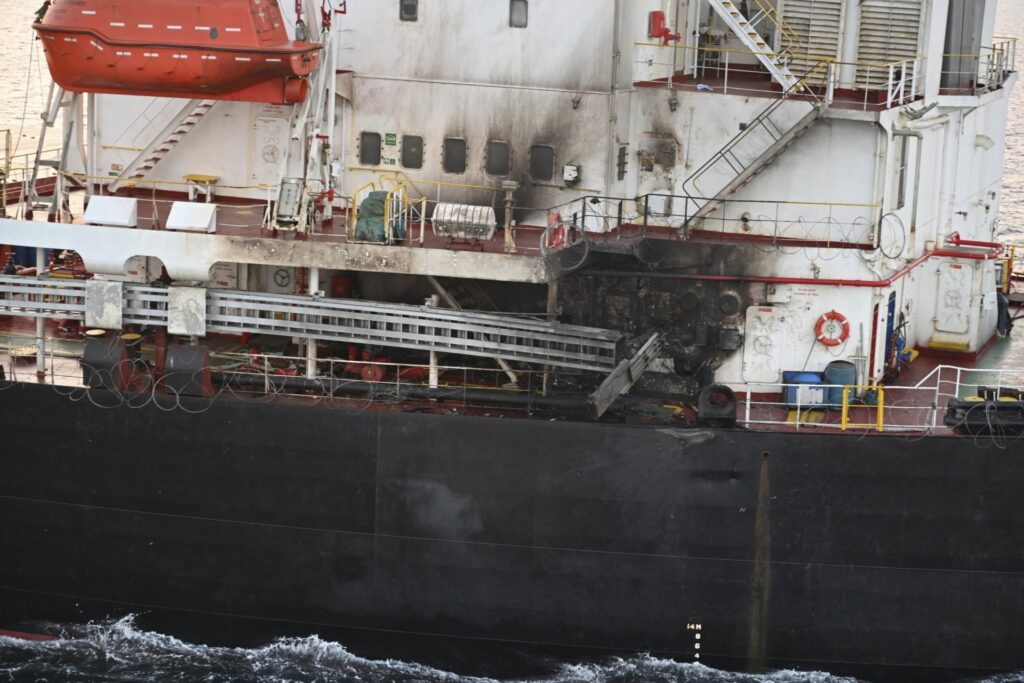The Iran-backed Houthi terrorists of Yemen on Sunday conducted what could be their most devastating attack on civilian ships in the Red Sea: a missile strike that appears to have left the Belize-flagged, British-registered cargo ship MV Rubymar badly damaged and in danger of sinking.
The Houthis said on Monday they “targeted two American ships in the Gulf of Aden” with further attacks.
Houthi spokesman Brig. Gen. Yahya Saree said in a televised address on Monday that the Rubymar took “catastrophic damages” from missile impacts and “came to a complete halt.”
“As a result of the extensive damage the ship suffered, it is now at risk of potential sinking in the Gulf of Aden,” Saree claimed.
“During the operation, we made sure that the ship’s crew exited safely,” he added, without providing any evidence that the Houthis took steps to ensure the crew’s safety.
U.S. Central Command (CENTCOM) confirmed two anti-ship ballistic missiles fired from Yemen on Monday morning targeted the Rubymar. One of the missiles hit the ship and inflicted significant damage.
“The ship issued a distress call, and a coalition warship, along with another merchant vessel, responded to the call to assist the crew of the MV Rubymar. The crew was transported to a nearby port by the merchant vessel,” CENTCOM reported.
The BBC reported on Monday that the crew of the Rubymar had to abandon ship because it was taking on water, and the vessel is now abandoned in the Gulf of Aden near the Bab el-Mandeb Strait. The company that owns MV Rubymar said the Houthi missile struck the ship’s engine room.
The United Kingdom Maritime Trade Operations (UKMTO) service said the ship is “at anchor,” and “military authorities remain on scene to provide assistance.”
The British government condemned the attack as “completely unacceptable” and said it “reserved the right to respond appropriately.”
Saree said on Monday the Houthis also “carried out two specific military operations in which they targeted two American ships in the Gulf of Aden” with “appropriate naval missiles.” He named the targets as the Sea Champion and Navis Fortuna. Saree’s Monday update also claimed the Houthis “targeted an American MQ9 aircraft in the airspace of Hudaydah Governorate” with a “suitable missile” while the drone was “carrying out hostile missions against our country on behalf of the Zionist entity.”
Saree further claimed the attack on the Rubymar “resulted in its complete sinking.”
The Sea Champion is a Greek-flagged, U.S.-owned bulk carrier that was hauling grain from Argentina to Yemen when the Houthis allegedly attacked it twice on Monday.
Officials at Yemen’s port of Aden said the ship was able to dock successfully after suffering minor damage and no injuries to the crew. The Yemeni officials characterized the Houthi terror attack on the Sea Champion as a “mistake.”
The Navis Fortuna is a Marshall Islands-flagged bulk carrier that took the precaution of broadcasting a message that it had an “all-Chinese” crew as it sailed through the Red Sea. The Houthis have promised safe passage to ships from China, Russia, and Iran.
Evidently, claiming the crew was entirely Chinese did not spare the Navis Fortuna from being targeted by a Houthi drone. The Ambrey private security company said on Tuesday the ship suffered “minor damage” from the attack.
The Houthis on Tuesday published a video of their fighters retrieving what appeared to be debris from an MQ9 Reaper drone off the coast of Yemen’s port city of Hodeida. The U.S. military had not confirmed the loss of a drone as of Tuesday morning.
The U.S. military conducted five “self-defense” strikes against Houthi targets in Yemen on Sunday, reportedly destroying three anti-ship missiles, a surface drone, and an unmanned underwater vessel (UUV).
CENTCOM said the Houthi targets “presented an imminent threat to U.S. Navy ships and merchant vessels in the region.”
CENTCOM added that the underwater drone represented “the first observed Houthi employment of a UUV since attacks began in October 2023.”
Former Pentagon official and CIA agent Mick Mulroy told ABC News on Monday that the UUV demonstrated “advancing Houthi capability” and a “shifting strategy”:
Unmanned surface and subsurface vessels are likely more difficult to detect and destroy than aerial drones and anti-ship missiles. The Houthis are not likely capable of manufacturing these weapons on their own, so they are probably coming from Iran.
Mulroy believed the Houthis and their patrons in Iran’s Islamic Revolutionary Guard Corps (IRGC) are “adjusting their strategy, apparently because they haven’t been successful in striking a U.S. naval vessel.”
The Houthis have attacked U.S. warships in the Red Sea with drones and missiles on several occasions, but all of their weapons were intercepted. The attack on MV Rubymar was by far the most serious damage the Houthis have been able to inflict on civilian vessels after dozens of terror attacks.

The U.S.-owned ship Genco Picardy came under attack from a bomb-carrying drone launched by Yemen’s Houthi rebels in the Gulf of Aden on January 17, 2024. (Indian Navy via AP, File)
Mulroy feared the Houthis could use UUVs to mount a “swarm attack” against an American warship that would be far more difficult to intercept than swarms of aerial drones and ballistic missiles.
The U.S. Coast Guard intercepted a shipment of arms from Iran to the Houthis in January that included UUV components, in addition to medium-range ballistic missile components, explosives, and networking equipment.

COMMENTS
Please let us know if you're having issues with commenting.